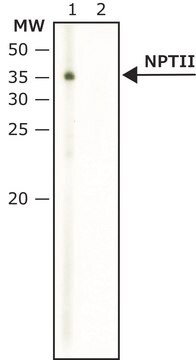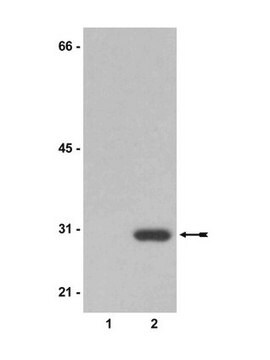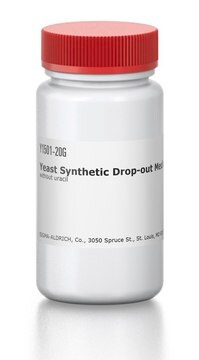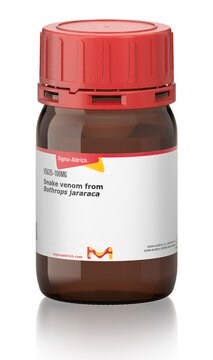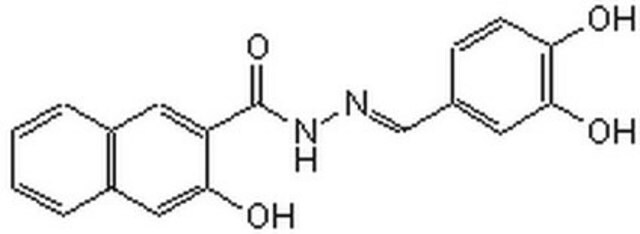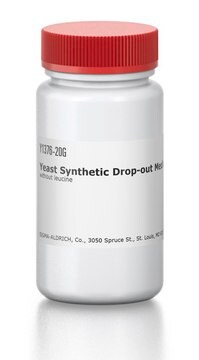176908
Anthrax Protective Antigen, Bacillus anthracis, Nicked, Recombinant, B. anthracis
Sinónimos:
PA 63, PA 63
Iniciar sesiónpara Ver la Fijación de precios por contrato y de la organización
About This Item
Código UNSPSC:
12352202
Productos recomendados
formulario
lyophilized
Nivel de calidad
fabricante / nombre comercial
Calbiochem®
condiciones de almacenamiento
OK to freeze
Condiciones de envío
ambient
temp. de almacenamiento
2-8°C
Descripción general
Recombinant, Bacillus anthracis anthrax protective antigen (nicked) expressed in a specialized strain of B. anthracis. PA63 is the carboxyl-terminal 63-kDa fragment obtained by the proteolytic cleavage of the receptor-bound protective antigen (PA), one of the three proteins that comprise anthrax toxin. Unlike native PA, PA63 oligomerizes to form a ring-shaped heptamer that binds up to three copies of EF and/or LF competitively and with high affinity (Kd ~1 nM). Whereas native PA persists on the cell surface, the heptamer is endocytosed, presumably because oligomerization aggregates anthrax toxin receptor. The endocytosed toxic complexes are trafficked to endosomal compartments where the low pH causes the PA63 heptamer to insert into the membrane and form a water-filled channel.
Recombinant, Bacillus anthracis anthrax protective antigen(nicked) expressed in a special strain of B. anthracis. PA63 is the carboxyl-terminal 63-kDa fragment obtained by the proteolytic cleavage of the receptor-bound protective antigen (PA), one of the three proteins that comprise anthrax toxin. Unlike native PA, PA63 oligomerizes to form a ring-shaped heptamer that binds up to three copies of EF and/or LF competitively and with high affinity (Kd ~1 nM). Whereas native PA persists on the cell surface, the heptamer is endocytosed, presumably because oligomerization aggregates anthrax toxin receptor. The endocytosed toxic complexes are trafficked to endosomal compartments where the low pH causes the PA63 heptamer to insert into the membrane and form a water-filled channel.
Acciones bioquímicas o fisiológicas
Cell permeable: no
Primary Target
EF and/or LF
EF and/or LF
Product does not compete with ATP.
Reversible: no
Advertencia
Toxicity: Standard Handling (A)
Forma física
Lyophilized from 100 mM NaCL, 10 mM BIS-Tris propane, 1.25% trehalose, pH 8.5.
Reconstitución
Following reconstitution aliquot and freeze (-20°C or- 70°C) for long term storage or refrigerate (4°C) for short-term (few hours) storage. Avoid rapid freeze-thaw cycles of solutions. Stock solutions are stable for up to 3 months at -20°C or -70°C.
Reconstitute in sterile 50% glycerol or sterile, distilled H₂O to a final concentration of 1 mg/ml. Addition of BSA to a concentration of 1 mg/ml may enhance stability.
Nota de análisis
Single major band at 63 kD by SDS-PAGE
Otras notas
Mogridge, J., et al. 2002. Proc. Natl. Acad. Sci. USA99, 7045.
Nassi, S., et al. 2002. Biochemistry41, 1445.
Singh, Y., et al. 1999. Infect. Immun.67, 1853.
Leppla, S.H. 1988. Methods Enzymol.165, 103.
Nassi, S., et al. 2002. Biochemistry41, 1445.
Singh, Y., et al. 1999. Infect. Immun.67, 1853.
Leppla, S.H. 1988. Methods Enzymol.165, 103.
Información legal
CALBIOCHEM is a registered trademark of Merck KGaA, Darmstadt, Germany
Código de clase de almacenamiento
11 - Combustible Solids
Clase de riesgo para el agua (WGK)
WGK 1
Punto de inflamabilidad (°F)
Not applicable
Punto de inflamabilidad (°C)
Not applicable
Certificados de análisis (COA)
Busque Certificados de análisis (COA) introduciendo el número de lote del producto. Los números de lote se encuentran en la etiqueta del producto después de las palabras «Lot» o «Batch»
¿Ya tiene este producto?
Encuentre la documentación para los productos que ha comprado recientemente en la Biblioteca de documentos.
Nuestro equipo de científicos tiene experiencia en todas las áreas de investigación: Ciencias de la vida, Ciencia de los materiales, Síntesis química, Cromatografía, Analítica y muchas otras.
Póngase en contacto con el Servicio técnico